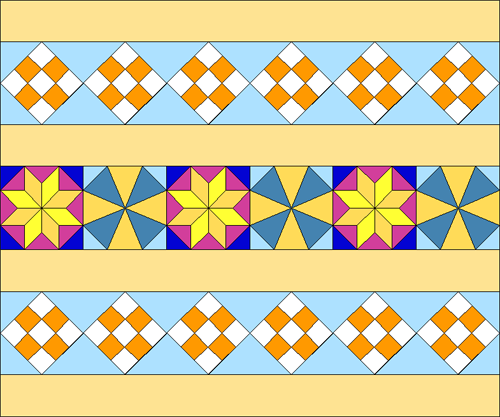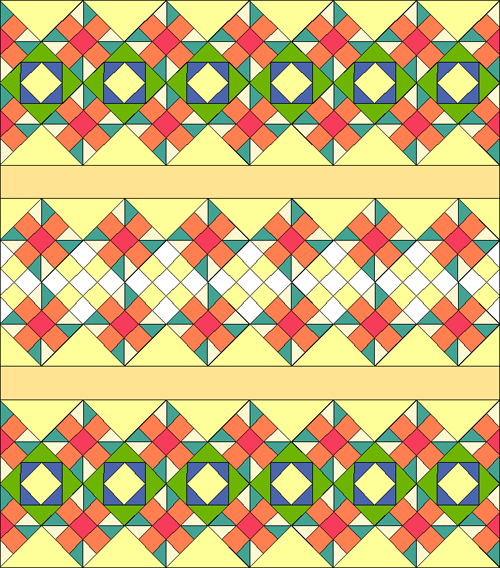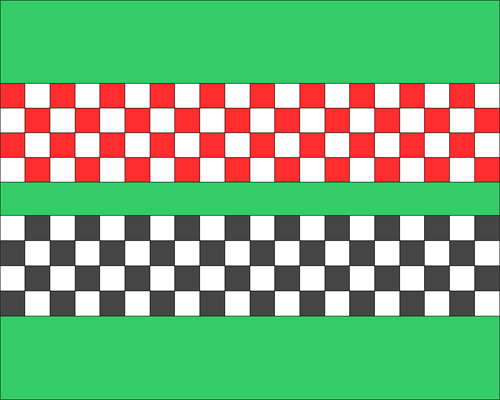Strip Styles
Strips can be set with plain or pieced blocks. The following styles are available when designing strip quilts:
Plain
Strip is one long piece for placing a print or solid.

Pieced Blocks
Divides the strip into rectangular blocks. Use the arrows to set the number of blocks.

Half Drop
Divides the strip into rectangular blocks with each end of the strip showing half a block. Use the arrows to set the number of blocks. The two half blocks are counted as one.

Spaced Squares
Divides the strip with equally spaced squares. Use the arrows to set the number of squares. The distance between the squares will vary as the number of squares is adjusted. As the number of squares increases, the squares will eventually become rectangles.

Points A
Divides the strip into triangles. Use the arrows to set the number of triangles. The base of the triangles is on the left side of a vertical strip and on the top of a horizontal strip.

Points B
Divides the strip into triangles. Use the arrows to set the number of triangles. The base of the triangles is on the right side of a vertical strip and on the bottom of a horizontal strip. In this sample, a block has been set into some of the triangles.

Diamonds
Divides the strip into diamonds. Use the arrows to set the number of diamonds. In this sample, a block has been set into the diamonds.

Half Drop Diamonds
Divides the strip into diamonds with each end of the strip showing half a diamond. Use the arrows to set the number of diamonds. The two half diamonds are counted as one.

Double Diamonds
Divides the strip into two rows of diamonds. Use the arrows to set the number of diamonds.

Half Drop Double Diamonds
Divides the strip into two rows of diamonds with each end of the strip showing half diamonds. Use the arrows to set the number of diamonds. The two half diamonds are counted as one.

Checker Board
Divides the strip into a checker board pattern. Use the arrows to set the number of divisions in each direction. The maximum number of divisions across the width is fixed at 8. The maximum number of divisions across the length is not fixed.

Tips on Designing Strips
It’s always easiest to design your quilt visually by simply looking at your computer screen and making your quilt look the way you want it. It’s important to remember that “what you see” will always be possible by using templates, but may not be suitable if you plan to use your rotary cutter. This may require some simple calculating for you. The formulas below may be helpful.
When using these styles: Pieced Blocks, Half Drop, Diamonds, Half Drop Diamonds
- To create perfect squares or 90 degree angles
Width of Strip multiplied by number of Blocks = Length of Strip
When using these styles: Double Diamonds, Half Drop Double Diamonds
- To create perfect squares or 90 degree angles
Width of Strip multiplied by number of Blocks divided by 2 = Length of Strip
When using these styles: Points A, Points B
- To create triangles with a 90 degree angle
Width of Strip multiplied by number of Blocks multiplied by 2 = Length of Strip
When using the Checkerboard style
- To create perfect squares or 90 degree angles
First divide the Length of Strip by the Width of Strip. Multiply that number by the number of blocks Across width. This will equal the number of blocks Across length.
How to get your Angles to be 90 Degrees within Strips
The examples below will help you create square blocks and right triangles.
Pieced Blocks, Half Drop, Diamonds, Half Drop Diamonds, Points A, Points B
- If you know the length (24) and width (4) of the strip already:
Length of Strip/Width of Strip = # of Blocks
Example: 24/4 = 6 Blocks - If you know the width (4) of the strip and the number of blocks (6) you want:
Width of Strip x # of Blocks = Length of Strip
Example: 4 x 6 = 24 Length of Strip
- If you know the length of the strip (24) and the number of blocks (6) you want:
Length of Strip/# of Blocks = Width of Strip
Example: 24/6 = 4 Width of Strip

Double Diamonds, Half Drop Double Diamonds
- If you know the length (15) and width (5) of the strip already:
2 x Length of strip/Width of Strip = # of Blocks
Example: 2 x 15/5 = 6 Blocks - If you know the width of the strip (5) and the number of blocks (6) you want:
Width of Strip x # of Blocks/2 = Length of Strip
Example: 5 x 6/2 = 15 Length of Strip - If you know the length of the strip (15) and the number of blocks (6) you want:
2 x Length of Strip/# of Blocks = Width of strip
Example: 2 x 15/6 = 5 Width of Strip

Checker Board
- If you know the length (30) and width (6) of the strip already:
# of blocks across width x Length of strip/Width of Strip = # of Blocks
Example: 4 x 30/6 = 20 Blocks - If you know the width of the strip (6) and the number of blocks (20) you want:
Width of Strip x # of Blocks/# of blocks across width = Length of Strip
Example: 6 x 20/4 = 30 Length of Strip - If you know the length of the strip (30) and the number of blocks (20) you want:
# of blocks across width x Length of Strip/# of Blocks = Width of Strip
Example: 4 x 30/20 = 6 Width of Strip - If you are trying to find the number of blocks to put across the width:
Width of Strip x Number of blocks along length/Length of strip = Number of blocks across width.
Example: 6 x 20/30 = 4 Blocks across width


 EQ Mini
EQ Mini

